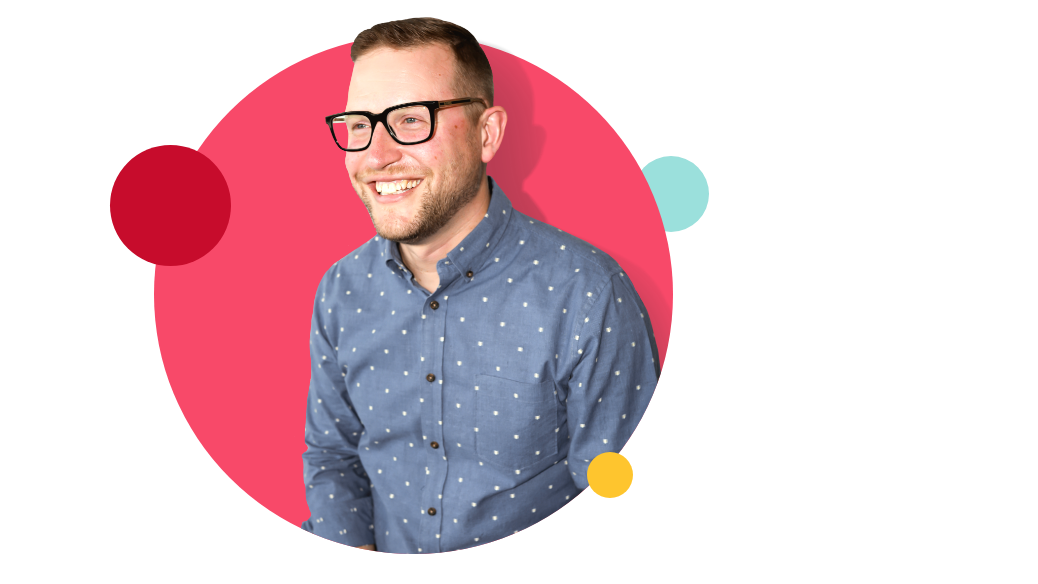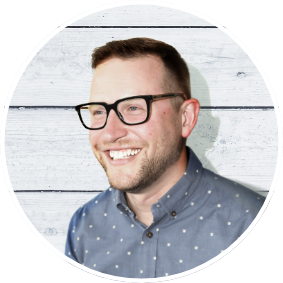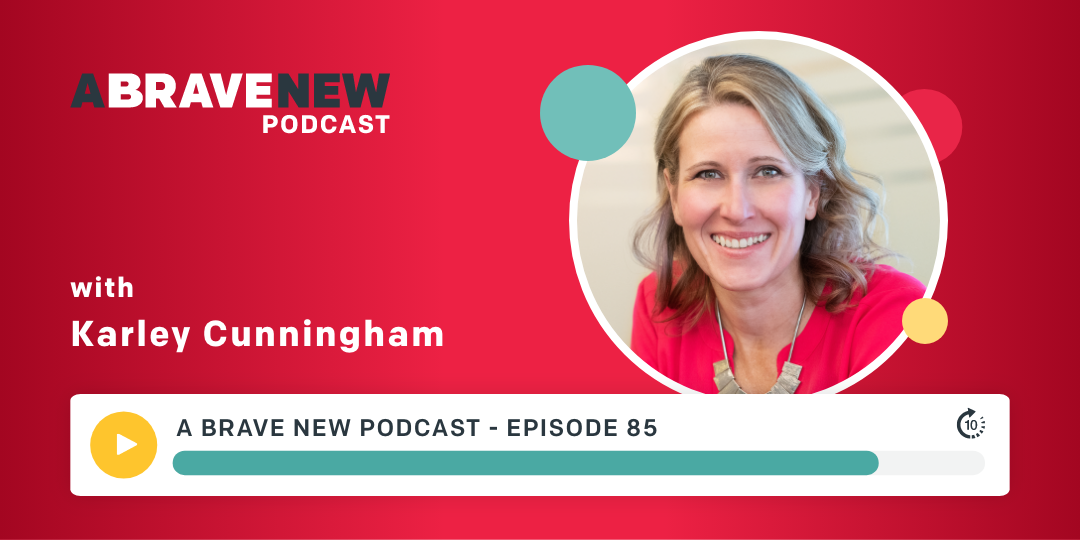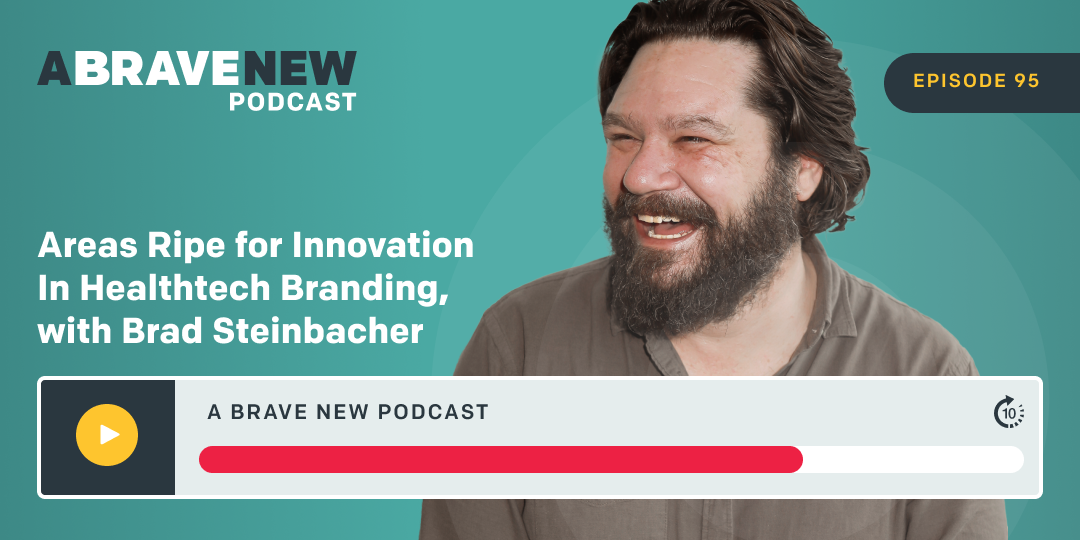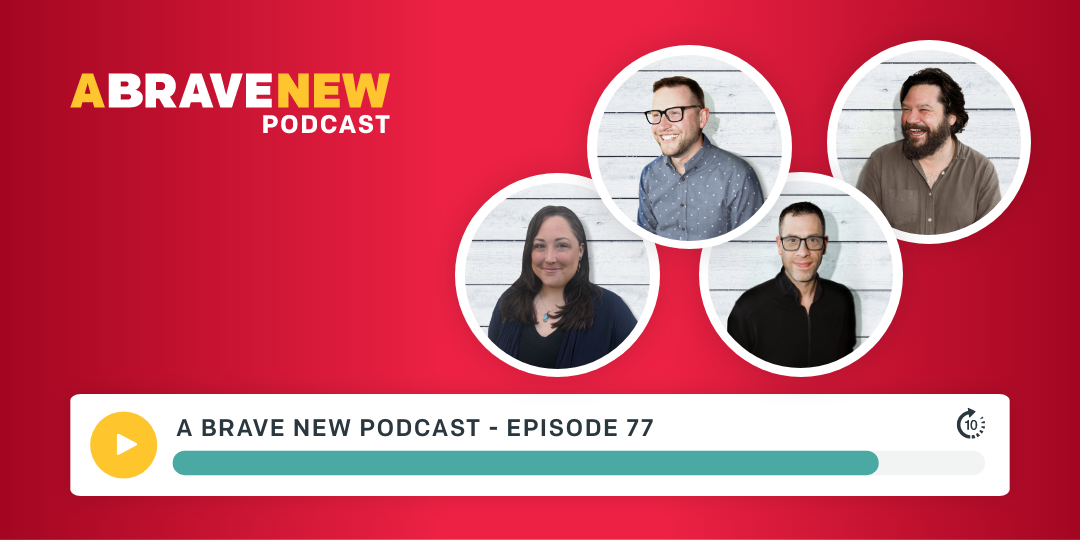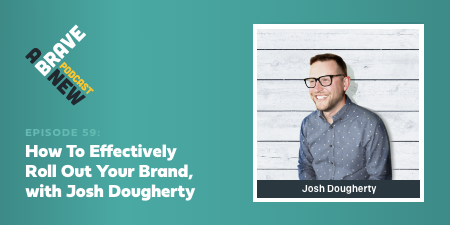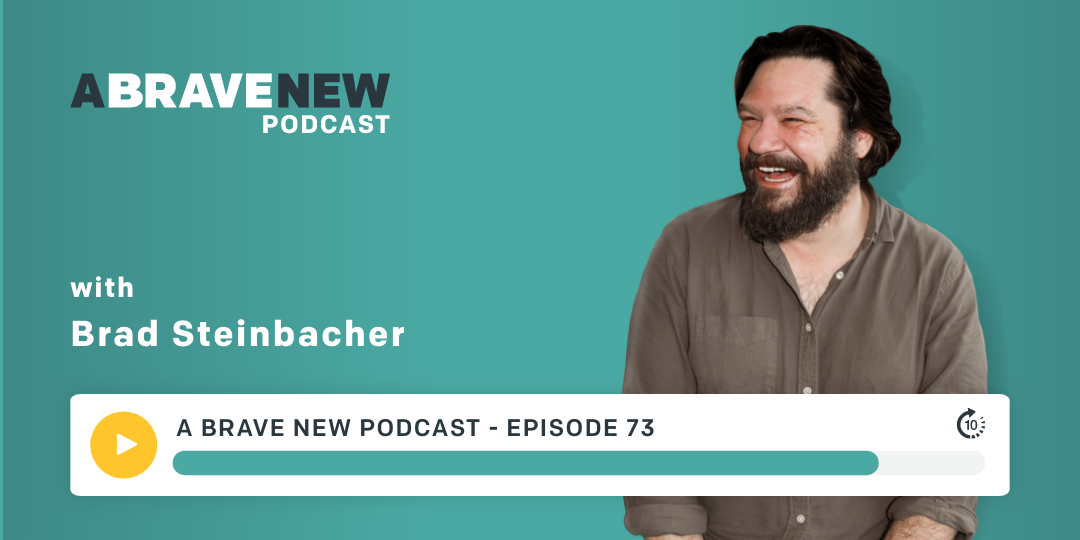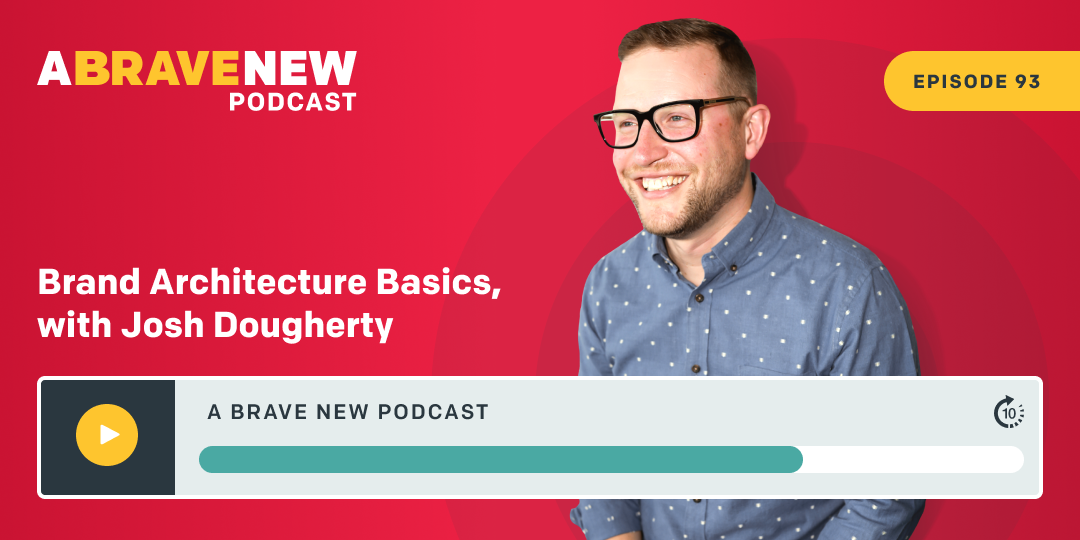Josh Dougherty is a brand strategist, speaker, and the founder and CEO of A Brave New, a Seattle-based B2B digital marketing agency specializing in tech and healthcare. Over the last decade plus, he’s worked with clients to develop unique brands and accelerate business growth using web design, inbound marketing, and account-based marketing strategies.
What you’ll learn about in this episode:
- Why trusting your gut is essential as you build your brand
- How to balance a commitment to data and other inputs with creativity and instincts
- That trusting your gut doesn’t mean ignoring or manipulating data to prove your point
- About three stories from Josh’s career that share why choosing to go with your gut and take a risk vs. taking the path of least resistance will drive the best results
Additional Resources
- Josh Dougherty on LinkedIn
- Josh Dougherty’s speaking site
- Heroic Public Speaking’s website
- A Brave New’s Website
Transcript
Josh Dougherty: Welcome to A Brave New podcast. This is a show about branding and marketing. But more than that, it's an exploration of what it takes to create brands that will be remembered and how marketing can be a catalyst for those brand’s success. I'm Josh Dougherty, your host, let's dive in.
Well, welcome to today's show, I'm really happy to have you along with me. Today, we're gonna dive into a topic that's pretty interesting. And that's about trusting your gut and branding. And this may strike many people as an interesting or curious choice of something to talk about.
Because today, we're no doubt in the midst of a data-driven society, I think as stuff has come up around AI, and as the usage of AI in our day-to-day lives accelerates, it seems more and more like, does that really mean anything anymore? Is it valuable? Is that something that we should be focusing on? That we should be making decisions based on? And as we build out our brands, we definitely need to be taking advantage of the latest technology, the latest data. We need to make sure we're listening to that data, and that we're searching for new data sources, new inputs to inform what we're doing.
But despite all this, despite where we are as a society, where we're going, all the inputs that we have at our very disposal, I do think that there's still a need to trust our gut. After all, really, as we think about building a powerful brand. This is both a creative and instinctual enterprise while also being strategic and data driven. And we need to make sure we don't divorce one side from the other.
Because if you are only having a data-driven brand, you're going to lose some of that heart and soul that lies at the heart of it. While if you are only going with your gut, being creative, instinctual, you might miss out on key opportunities, key trends, key things that are happening in the marketplace. And so, as we focus in on this creative and instinctual side of our work, building great brands, I think it's inherent and important for us that we trust ourselves on our instincts, in order to be successful.
So today, on the pod, I really want to just unpack what it means to trust your instincts when you're building your brand. I want to do that by exploring a few instances where I chose not to trust my gut and learned the hard way. So let's dive in and unpack this a bit.
But before we get to the stories, which is what most of today will be about, I do want to stop and talk about what trusting your gut isn't. So when I'm saying you need to trust your instincts, trust your gut, moving forward, there are a few things that it doesn't mean when I'm referencing that. The first is trusting your gut or trusting your instincts doesn't mean ignoring the data in front of you. Data exists for a reason, and a lot of times it can help guide us as we make decisions and help us make better decisions. And so we need to be constantly, as branders and as people who are trying to build experiences for the audiences and engage with our brands, trying to draw people in and trying to build emotional ties. We need to really listen to the data that we have out there. The data points on engagement, the data points on why people love your brand, why they want to keep coming back. Maybe the quantitative trend lines that show whether something is resonating with people or if it is not. Maybe it's data about the engagement of your team around the message of the brand and their ability to live out that brand. So we're going to have a ton of data points at our fingertips and another might be the data we have about our competitive atmosphere and the gaps that we have that we can exploit as opposed to our competition. So with all these data points coming in, we need to make sure we have a system for ingesting them, understanding them, and then listening to and responding with action as we build the brand. And so, trusting your gut does not mean ignoring the data in front of you.
The second thing that it doesn't mean is that trusting our gut or our instincts doesn't mean manipulating the data. Now, this is a common thing. And I think when we talk about manipulation, people often look at this word as being a super negative word. I don't see it that way. Manipulation is about changing something, about adjusting something. And so when I say, don't manipulate the data, I am not saying that everyone who does this is maliciously out there changing the data to back their perspective or their point of view. I think the maliciousness isn’t inherent. I think our minds are natural consensus builders.
So, as we go through our thought process, and we're trying to build a case or make a pitch for an idea, we're going to naturally think about what data actually backs us up. And then as we look at a data set, right, we only pick out the points that match up with our perspective, or we reorient how the points are shown, so that they match up to their or our perspective. And this is very dangerous because this means we might be missing the point of major data trends. Or we might be missing other data that shows the exact opposite of what we want to prove, just because we've looked at the data with rose-colored glasses. So the second point, after ignoring the data in front of you, is making sure we don't manipulate the data that we have to match maybe our instincts or our gut. Because there are times when data will tell us very clearly that our instincts are wrong. And we need to listen to that. And now, if you're still in the camp of thinking manipulation is evil, the other thing you shouldn't do is manipulate the data that you know is saying something else to back your position or your instincts about the brand.
And then, the final piece here of what trusting your gut isn't, is that it doesn't mean taking a step forward without seeking the necessary inputs to be successful. So what I mean here is really core, I think, to what branding is to be successful. In building a brand, we need to listen, we talk a lot in the branding world, right, about how the brand exists in the minds of our audience. I talk about how, when we're building a brand, we are curating a specific memory, and that a brand, a company, is only as important as the memory it leaves in its customers' minds. And so in order to build a great brand, we've got to understand what people are thinking, we need to understand the inputs that we have. And so, trusting our gut doesn't mean taking steps forward without seeking out those inputs. It means that we thoughtfully listen, we internalize, we try to put things together, make connections, build ideas. And then if our gut is telling us to move somewhere, we move because we are allowing it to be informed by data. But then, trusting ourselves to make the hard call. And if we can do that, we're going to be successful.
So, in summary, we need to trust our guts to build brands because building a great brand is about being data driven, and about being creative and instinctual. But trusting your gut doesn't mean ignoring the data in front of you, manipulating that data, or not seeking out the necessary inputs as you're making a decision.
So with that kind of common ground down underneath us, I want to shift to the bulk of our conversation, which is around the importance of trusting those instincts, trusting your gut, and brand building. And I want to do that by sharing three different stories from my past experience. And in the first couple of stories, you're gonna see a couple of commonalities. These are stories about experiences I've had working with clients where I chose not to trust my gut and where it resulted in less than ideal outcomes, right? Or it resulted in us not achieving the potential that we had. And then the third story is about a moment when I did trust it. And the outcomes have been great so far.
So why have a conversation about this? Before we dive into the stories, the reason I think it's important to have a conversation about this is because, for the most part, working on throughout my career, working on brands, large and small, and I think I've experienced this as I've talked to other people who work on brands. I've often found that my lizard brain, the part of my brain that doesn't want to take risks, that wants to just exist in the status quo, makes me, pulls me back from making a stronger gut decision. And typically that stronger gut decision, if I had followed through with my instincts, would have resulted in a more comprehensive brand rollout, a better brand experience, better results. And so, but we can use data to kind of pull us back from making that riskier decision sometimes. Or we can convince ourselves that that risky decision isn't worth it. And I want to encourage us to say when we have this creative idea, or a big idea, we need to push beyond it for our brands because for our brand's sake, we're trying to build something—an amazing, unique experience, and that requires amazing and unique ideas, not just being safe.
So let's tap into story one. Story one is a website story, right? I built a lot of websites in my career. Probably, I don't know, dozens at this point. And websites I love to work on because websites really are that primary brand expression online. And for a lot of brands, or b2b brands that we work with, and maybe the primary brand expression period, it's that flagship space where you get a chance to tell your story, to influence people to get them excited about who you are and what you do. Now, this story is a story about a website, that probably should have been a story about a website redesign for the sake of shoring up a brand, because, as I just spoke about, websites are foundational brand experiences. But sometimes, they end up getting overlooked because we're looking to prove our ROI for our work.
And side note, this is something that agencies especially have to do when they're starting a new client engagement, they may have pressure to deliver results quickly. And so the focus on the ROI driving stuff up front. The challenge is, when you only focus on stuff that shows immediate ROI, if you have another part of your program that's relatively broken, right? Like a website, you're going to end up crippling your ROI-driving activities. Because the thing that may not have inherent immediate ROI on it, like a website redesign, is the thing that's going to facilitate the rest of the success in your marketing program. And so, we need to remember that we're thinking about, that it's important to think about, the long-term ROI and the long-term good, not just the short term.
So in this specific instance, that happened a while back, my client had a website that wasn't working. The design was relatively dated. The layouts were dated. The brand was somewhat dated. There was not enough of a distinct opinion that was showcased on this site: how they do the work, what makes them different, even though inherently they're a very different, awesome organization. You couldn't tell if you went and looked at the site, right?
The content was pretty thin as you looked at service pages or industry pages or places that were meant to showcase their uniqueness. There was thin content, a couple paragraphs, maybe some bullet points but nothing that would inherently draw you in and make you excited, help you see, really what was amazing about this organization. And so that wasn't it, though there was a lack of functionality to showcase the value of the brand on the site. And over the long term, over the last four to five years, when we started getting engaged with this client, there hadn't been a comprehensive content strategy or content creation plan. And so SEO was fading.
Now, if I look back and zoom back to those first engagements, the case in front of me was pretty obvious. I could step back and say, you know, what really needs to happen before we start diving into marketing, we need to recommend some really solid visual identity work, we need to refresh your brand for the future. And we need to redesign the site. Now, the challenge is, when me as CEO of A Brave New starts thinking about that, sometimes, the lizard brain or the more conservative part of me starts worrying aboutwhat the director of marketing or the CMO across the table was thinking about And I worry that if I suggest something that's going to maybe take six or seven months to complete, that is going to get us to a much better foundational place—I start worrying that they're not going to want to move forward. And so I work on, you know, focusing on executing marketing, which we can still do successfully, but eventually we're gonna have to come back and pay the piper right and do the work.
So my gut in that moment, as I looked at this website, and if you'll notice, I was looking at the data, right, I was taking in the inputs, I was being analytical. And what my gut told me was, we need to do some visual identity work, we need to redesign the site. Because this is a company that has a massive story to tell, they're a huge success, they have a big growth trajectory. And you know what I did in that moment, I silenced my gut. And I said, no. The goals we're trying to attain with marketing are doable. We can do the brand later. And this wasn't untrue, the goals were doable. We said, we’ll set a conservative projection, right, we'll be able to hit it, and then we'll come back and do the website, some brand work later. But as we did this, you know, over the subsequent months, there was some erosion in the performance that continued.
And oftentimes, as we say, okay, we’ll work on the brand. Once we've established this precedence, that marketing execution is more important, that brand often never comes until it's a crisis. And then, once again, rather than looking comprehensively at the brand and saying, okay, if we have this amazing value-based platform, we have this amazing vision for where we're going with this huge growth trajectory, instead of looking at that and saying, how do we express that to the world in a unique way? What is that memory then that we want to leave with people, after they engage with us? Instead of doing this, later hasn't come, there's another crisis. And instead of doing that comprehensive rethink, we choose the path of least resistance. And we again, move down a path of probably still good, because we're good marketers, we're going to do great work, and you're a good marketer, and you're gonna do great work.
But we miss out on that opportunity of what a brand brings us, which is to be great, which is to redefine our category and stand out above all our competition, which is to free ourselves from worrying about: are we pricing this right? Because people want to beat down the doors to work with us, which allows us to have alignment internally, because we all know what we're saying and how we're telling our story. And so, in that moment, with this website, looking back on it, I wish I hadn't chosen the path of least resistance, that I built a strong foundation and moved on to driving leads and closing deals afterwards.
Now, I will say, for some of you, it's not a zero sum game, you can do some lead gen, you can close some deals, and you can do brand at the same time. But I would encourage you on these big capital projects, stop and take the time before the crisis. Because if we stop and take the time before the crisis, we can craft what the experience is going to be, and then build an intentional marketing program around it.
So story, one, trust your gut, when it's saying stop and look at the big picture. Trust your gut when it's saying let's do the things that aren't driving immediate ROI to set us up to drive even more ROI down the path down the road, and get ready to go. Step out. Take Action, go for it. And if you need to do some lead gen, etc. along the way as you're building the foundation, but don't let doing lead gen ABM optimization happen in lieu of the brand work that is going to set you up for success in the future. All right. So we want to be bold about that. We want to trust our instincts.
The next area, the where I want is a story. Or the next story I'm gonna tell today is about failing to trust instincts and taking advantage of an opportunity to transform culture with a brand. So the story is about a brand that I worked with about a decade ago. And this was with an international relief and development organization, so a nonprofit that's doing work around the world to help do economic development, take help with food relief, help with major disasters when they're happening. And I participated in that branding process. And me and my good friend, Steve, who you've heard on this podcast a couple times, we're working together, specifically on the brand implementation.
And here's an aside about implementation. If you've never been through a brand implementation process, it can be difficult. It requires a lot of consistency. It can't just be about marketing, right? It has to be about the whole organization. And even for those of us who like a good strategy, we like a good concept - it is … man. It's all about people. So you've got to engage with people, you've got to get into the mess, you’ve got to work through it with them.
So anyways, this instance, we were partnering with another agency and they were leading the initial morning brand concepting, so we got through that brand concepting. They had a brand essence that was pretty strong. And then we took what that agency had done. And we built out a full blank brand platform with things like core identity, attributes, personality, tone of voice, etc. And after we've gone through that process, it was our job to implement. So we helped plan out the implementation process.
Now, this organization wasn't small, they are big, hundreds of employees, probably thousands, If you count their overseas employees. And so it was a complex process. And I specifically was focused a ton on the brand messaging, tone of voice, and also planning out the brand training with Steve. But the problem is, it couldn't overcome brand training alone, in this instance, couldn't overcome a culture that wasn't ready for transformation.
And what do I mean by that? Well, I mean, that you had a culture that was naturally somewhat skeptical about a new brand, a new initiative, trying to make things look fresh, trying to make things look clean. I'm not sure of all the factors that were influencing this experience because I think some of them were pretty difficult. But there was a bit of lack of trust in the organization, and a bit of nervousness about change, no doubt. And so when you come across something like this, there needs to be a deep push by leadership to really address those core issues before the brand is going to really take hold.
And in our guts, I think both Steve and I knew this, because we would talk about at the hotel about the deeper changes that needed to happen, the ways that the leadership needed to engage and build trust, the ways that there needed to be some deep conversations, some deep transformation moments. But at the end of the day, we unfortunately pushed a little bit on leadership and had some hard conversations. But we didn't put a stake in the ground, we didn't trust their guts and say, this is the thing that is gonna be make or break about this brand. We don't get the culture on board, if we don't get people changed. We're not long term going to have as much of a transformative impact. As we could have, sure we're going to launch a great brand, it's going to look good, the messaging is going to be good. There's going to be some wins internally, but we're going to have less of an impact than we could. But we played it safe. We chose simply to do brand training. And you know what happened? That first day, we were doing training, a young designer named Chris came up to me and said something that I remember to this day, I can't remember where I'm sitting, I can remember looking over at him. He said, I don't know what this brand stuff is all about. It's so disingenuous. It's just another marketing ploy.
Ouch. That hurt. This was someone who had been, I've worked with a decent amount throughout the process. Someone that had been involved, someone who knew more than the average employee, he was even in the marketing function, right. And he tells me, it's just another marketing ploy. Just more words, we've failed, because we hadn’t pushed for a bigger systemic change. We've done all that hard work to get to a specific point. But we failed because it was safe. And our gut was telling us to do something that was a bit more risky to really push, to challenge leadership. But we chose instead for the safer thing. And who knows if leadership would’ve gone about it as an agency. You only have so much influence, right? To get them to change. But we should have pushed harder to make that change happen. And now the brand launch was still relatively successful. Today, the org continues to thrive. But I kind of will never forget that opportunity to do something bigger. That would have been even more transformative, if only we had trusted our gut and gone big.
And so looking at these two stories, right, this international relief and development organization where we didn't push for transformative cultural change. And this other organization where we didn't push to stop, pause, rethink the visual identity, rethink the web experience before we moved into marketing. Both of these are examples of us saying, “You know what, the path of least resistance is going this way.” And we can still be moderately successful by going down the path of the least resistance, but instinctual branders who trust their gut know that the path of least resistance usually isn't also the path to the best results. You can be the path to good results, but not the best. And so I encourage you to learn from those buffalo stories. That pushing yourself away from the path of resistance, trusting your gut and taking the hard steps to be transformative about your brand is going to drive huge results for you.
And now story three. I'm going to close out on a positive story. It's about trusting my gut. And it's about the A Brave New brand, a brand that I care about very deeply because this is a brand that I've built over the last nine years, initially with my business partners, Polly and Jacob. And now, with myself, with numerous other people we've cultivated, tried to cultivate a brand presence, we've tried to cultivate that unique memory at the heart of who we are. And as I mentioned, ABM started nine years ago, so we're coming up on 10 years next year, which is crazy, I feel a little bit old to have been in business that long.
But here we go, I launched it with a couple of my good friends, Jacob and Polly, no longer working here, but also huge influences on where the brand went and how it grew. And then, over time, this brand has grown and evolved until I arrived somewhere early in 2022. So about a year ago, a year and three months ago. And over the pandemic, I have been working on a keynote speech around branding. This is something that is super important to me. And one of the tools or the catalysts for doing this was attending an amazing public speaking course called Heroic Public Speaking with Michael and Amy Port. I'll leave some notes in the show notes. But they have a program called HPS Grad. And in HPS Grad, you spend 12 weeks working on an idea for a speech, building out a whole script for a keynote. And then after that, you spend over the course of four or five months, about five, three and a half day sessions at their headquarters out in New Jersey, learning how to deliver this keynote and learning how to speak. And it is a transformative experience. Really, truly one of the best things that I've done in my career, something that helped me find my voice and become excited about what I'm doing.
But I want you to come back with me to that time, I think it was February 2022. And one of the things that we are doing in New Jersey at this session in February, is that we're talking about our personal speaking brands. And Sienna, who leads the conversations around brand and their programming, is sitting and talking about what are the attributes that you want your personal speaking brand to have? How do you want to show up? How do you want people to perceive you? What's the feeling? What are the emotions? All these things that we talked about in branding every day. And I'm sitting there in my chair, I'm reflecting a little bit about how I want to show up as a public speaker, as someone who is sharing with others about my knowledge about branding. And all of the sudden a thought hits me like a ton of bricks. And it's kind of unfair to say it's a thought, I think it's like an emotion as well, right? Because at first, I felt the weight land on me. And the thought or the emotion or the realization that hit me was that ABN’s brand didn't fit the company that I wanted to have. The way ABN evolved didn’t fit. And the way ABN was showing up in the marketplace didn't fit with who the company I wanted to own.
It didn't fit my strategy, it didn't fit. Its focus didn’t fit where I wanted to be going. This was tough, right? Because you are super invested. If you own your own business, you know how invested you are.
And this started a really long soul searching process and resulted in a number of things, shifting our sales approach to sell the services and the things that I really fully lean into selling the services and the things that I care about, moving away from selling as much inbound marketing, and etc. And focusing heavily into branding, and building brand experiences online. And building, you know, doing great work to build brands. It resulted in us shifting our brand and look and feel completely away from where we had evolved, to something that was more dynamic. It involved niching down to areas where we were experts to say, you know what, we don't want to be an expert in everything. I want to be focused on places where we can do really amazing high-quality work. And it started me on a process of being willing to turn down business that doesn't fit for me and for our organization.
And this has been one of the most I mean, exciting, transformative 16-18 months of my life but it has been super, super hard, right, to say we're gonna turn this ship and turn it into something that really reflects who we want to be as a brand in the world. It's been the road less traveled. But it has been that road right traveled. Because at that moment, as I was sitting listening to Sienna, in New Jersey talking about speaking brand, and I was immediately struck like a ton of bricks with this idea that the ABN brand had become something that wasn't the brand that I wanted to have, wasn't the brand that the agency needed to be to be successful. Instead of saying, you have it, it feels comfortable.
I chose to come home and take the first baby step in trusting my gut, start moving to evolving our services, and then our look and feel, and then our niche. And then, getting to the point even where we're willing to turn down business. And throughout that process, there's been bumps in our business and in the work and the road. But each time some adversity has struck, we've said, let's lean further into the direction that we're going. So that we can build a brand that isn't right for everyone. But it's right for the people who love us. And right for the people who truly need our services. And it's something that we can be so excited about too.
And so I tell that story to encourage you to say there can be amazing outcomes, if you trust your gut. You take all the outputs and the inputs into consideration, all the data into consideration. But you just take the step and make the bold decision. And I also tell that story to say that making the bold decision isn't about making that decision all at once.
For me, it was about coming home and saying to my team after I had been at Heroic Public Speaking in February 2022, saying we're going to shift our sales approach and try to become more about selling brand and brand experiences and marketing strategy and not as much about inbound marketing execution. Which seems really hard to do. Say this is how we make money, this is how we’re successful.
But it's the right thing to do. And it took that first conversation and then taking the next step about 50 times after that. And probably honestly for the next few years, about 50 more times to head down the road to making a bold brand that not everyone—it's not right for everyone. But for the people it's right for it's going to build radical allegiance and trust.
So with that, I want to close out. I want to remind you, branding is creative, it's instinctual. And at the end of the day, as I'm closing out this podcast, I think the thing that I'm realizing is that building a great brand is about being brave enough to go against the path of least resistance. It's about being bold. It's about taking brave steps, so that you can be remembered, not just be moderately successful but be great. And so, I want to encourage you as we close out, to be bold and think about your brand. What is that next step that I need to take to transform how I show up and to transform how our organization or our brand shows up? And live into that unique essence of who you are just a little bit more.
All right. That's all we have for today. We'll see you next time.
Thanks for listening to this episode of the brave new podcast. Go to abravenew.com for more resources and advice on all things brand and marketing. If you enjoyed this episode, show us some love by subscribing, rating, and reviewing A Brave New podcast wherever you listen to your podcasts. A Brave New podcast is created by A Brave New, a brand and marketing agency in Seattle, Washington. Our producer is Rob Gregerson of Legato Productions
Similar Articles
OCT 11, 2021

The Beginner’s Guide to Generating Inbound Leads
Marketing doesn’t have to be painfully intrusive, like getting yet another telemarketing call right when you sit down to dinner with your family.
OCT 11, 2021

The Beginner’s Guide to Generating Inbound Leads
Marketing doesn’t have to be painfully intrusive, like getting yet another telemarketing call right when you sit down to dinner with your family.

